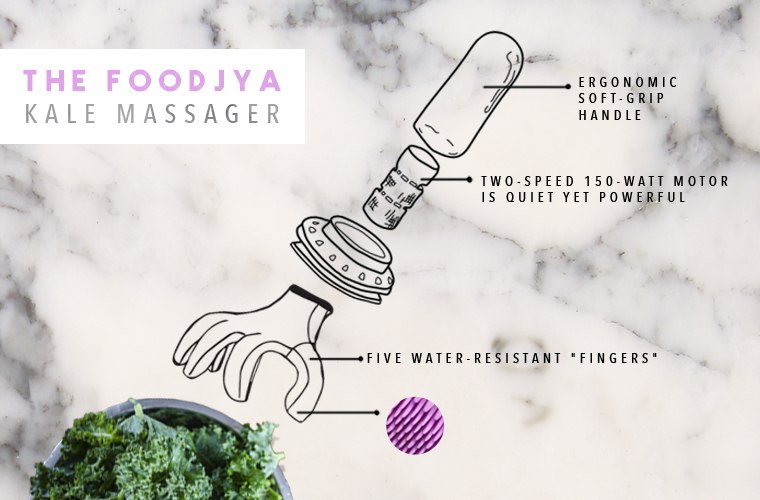Is the Kale Massager the Greatest Invention Ever?
"I had one of those endless days, where I ran from work, to a doctor's appointment, to the gym, and by the time I walked through the door, I was starving—and it was already 9:00 p.m.," she remembers. Things only got worse from there: She had a refrigerator crisper full of kale that was ready to eat—once it was massaged. (For those not familiar with the technique, kale massaging—literally giving the leaves a rubdown with whatever dressing you're using—helps break down the plant's cellulose structure, thereby making raw kale way less tough and, by extension, way tastier in your salad.)
"While I stood in my kitchen watching the clock tick away, my feet aching and hands coated in olive oil and lemon as I gave the greens a deep massage, I realized that there had to be a better way."
She may be right: After three years of tinkering, consulting with everyone from gadget designers to nutritionists, Deng officially found her solution in her Foodjya Kale Massager.

Think Cousin It-meets-C-3P0, but for your salad. The massager features five water-resistant "fingers" that have been wired to move just like a human hand (Deng spent a month studying massage therapist's movements in order to get the motion just right), with an adjustable clamp keeping the entire arm steady.

{{post.sponsorText}}
The Foodjya attaches to bowls both large and small—but not plates because, as Deng notes, "eating off of plates is so 2015—I don't know anyone who still does that." (Plus the device requires a kind of leverage; we notice that high-lipped bowls work best.) You can choose your setting, from "Quickie," which takes the edge off of your kale's crunch in just five minutes, to "Melted," which gets it buttery soft in under 10.
"Just as we see an endorphin boost in humans after they've received a massage, kale acts similarly—it releases more of its vitamin C and calcium, making it more bioavailable"
But the Foodjya is more than just a time-saving device; a recent study suggests that massaging increases kale's nutritional profile. "Just as we see an endorphin boost in humans after they've received a massage, kale acts similarly—it loves being touched, it feels happy, and so it releases more of its vitamin C and calcium, making it more bioavailable," explains Dr. May B. Knaut, who led the 2015 Harvard University nutrition science study. While she admits that more research needs to be done, she believes that kale massaging will only become more prevalent as science backs what many pro and at-home chefs have known for years.
Which concerns Dr. Joe Kerr, an orthopedic specialist at New York City's Hospital For Special Surgery. "You have no idea how many patients I see every month who have aggravated carpal tunnel syndrome, due to spending too much time massaging their kale," he says. (Not to mention cellphone use.) "Everyone likes to talk up kale's nutritional benefits, but no one is aware that it has this dark, dangerous side." While he noted that he hasn't yet tried the Foodjya, he's optimistic about the development. "Anything that limits interaction between human hands and kale is a step in the right direction."
And Deng couldn't agree more. "I think this device can help so many people: Working parents to women who just got a manicure and don't want to mess up their nails...really I could go on and on," she says, adding, "And that's what the Foodjya is all about—spreading happiness, one kale massage at a time."
The Foodjya is available at Amazon.com for $99. (Also: April Fools!)
Looking to keep your kale cooked? These 10 recipes featuring kale are delicious, no massaging necessary.
Loading More Posts...